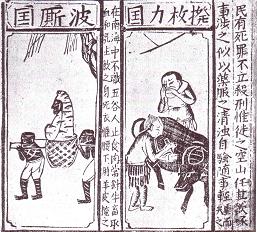I found this interesting piece there are Somalis that drink blood like the Maasai

You don't have permission to view the spoiler content.
Log in or register now.
Do you think somalis still practice blood drinking?The Rendille and other 'Nilo-Cushites' in northern Kenya have been influenced by Maasai/Turkana/Samburu type Nilotes culturally. The practice is Nilotic, not Cushitic.

Do you think somalis still practice blood drinking?
So its a bantu thing?I found this interesting piece there are Somalis that drink blood like the Maasai
View attachment 65178
You don't have permission to view the spoiler content. Log in or register now.
I'm guessing it's an Ogaden thingSo its a bantu thing?
You started a fkd session. Wait till they see this shitI'm guessing it's an Ogaden thing
I knew it wasnt possible. The ulema drink blood.

We drink the blood of Ethiopians after slaying them for lunch

Explain this depiction of ancient Somali's thenThe Rendille and other 'Nilo-Cushites' in northern Kenya have been influenced by Maasai/Turkana/Samburu type Nilotes culturally. The practice is Nilotic, not Cushitic.

It’s actually the other way around, blood drinking is known to be a Cushitic practice adopted by some Nilotics similar to how they adopted our aversion to fish:The Rendille and other 'Nilo-Cushites' in northern Kenya have been influenced by Maasai/Turkana/Samburu type Nilotes culturally. The practice is Nilotic, not Cushitic.
It’s actually the other way around, blood drinking is known to be a Cushitic practice adopted by some Nilotics similar to how they adopted our aversion to fish:
https://books.google.ca/books?ei=BGV4TvazCsa30AHS1MjxDA&ct=result&id=MMc9AAAAIAAJ&dq="Some+Nilotes+have+adopted+the+Cushitic+custom+of+drinking+"&focus=searchwithinvolume&q="Some+Nilotes+have+adopted+the+Cushitic+custom+of+drinking+"
The geographer Artemidorus, writing around 100 BCE in passages passed down to us by Diodorus Siculus and Strabo, described them as living "a nomadic life on their flocks, each group with its ruler. At the time of the Etesian winds, when there are heavy rains, they live on blood and milk, which they mix together."
That was a 100 BC description of the lifestyle of certain Blemmye tribes in Northeastern Sudan (ancestral Beja tribes).
Here is a Chinese source on Northern Somalia during the early medieval period (800-900 CE) that describes the local nomadic pastoralist Somali inhabitants as not only being able to hold back the forces of the "Tazi" (The Caliphates) with a force of 200,000 soldiers (likely an exaggeration to merely put the point across that they had a powerful fighting force) but also having practiced this same custom of drinking cattle blood with milk:
"The people do not eat any of the five grains but they eat meat: more frequently even they pick a vein of one of their oxen, mix the blood with milk and drink it raw."
I was going to say this and you beat me to it, the Nilotes learned this from Cushitic people not the other way around, and northern Nilotic people who haven't been influenced by Cushitic people don't practice it.
It's not barbaric at all it's actually pretty smart. With blood and milk you can get most of the benefits you would get from eating your livestock but you don't kill them, so you still have your livestock afterwards.
Some of the "Nilotic" tribes are probably originally Cushitic tribes that adopted Nilotic languages. There's good evidence that the Kikuyu are originally a Cushitic tribe that have adopted various Nilotic and Bantu influences.
The original Cushitic pastoral people:
- Worshipped Waaq the sky god, the place of worship under a wagar tree (african olive tree). The wagar tree connected heaven and earth.
- Practiced cattle pastoralism (later some adopted camel pastoralism) and lived off blood and milk, avoiding slaughtering their animals as much as possible.
- Society was egalitarian with age sets and age grades determining the social role and social standing in the community along with how the community was organized and led.
- Practiced circumcision upon graduation into the age set allowing marriage.
- Spoke a Cushitic language
- Have two moieties, one junior, one senior